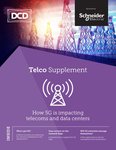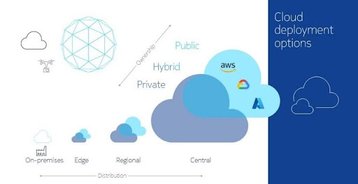To help enterprises shift to Industry 4.0 and realize 5G’s full potential of offering new customer experiences, communications service providers (CSPs) have begun deploying 5G core networks on private, public or hybrid clouds, with initial deployments already in commercial service.
Hyperscalers’ public clouds, such as Amazon Web Services (AWS), Google Cloud Platform (GCP) and Microsoft Azure, are used by some CSPs to establish a 5G standalone core, whereas hybrid clouds, as the name would suggest, facilitate workloads between private and public clouds or even via public clouds deployed on-site.
And while there are risks with choosing to deploy onto a public or hybrid cloud, CSPs utilizing this route could also experience significant rewards.
The advantage of utilizing public and hybrid clouds for 5G core deployments
One of the largest advantages is simply working with hyperscalers, which have the expertise, infrastructure and systems to handle complex cloud services. CSPs can achieve faster time-to-market and improved operations by taking advantage of hyperscalers’ pre-existing continuous delivery services, automation and analytics capabilities, allowing CSPs to focus on service differentiation instead of the underlying cloud platform.
By optimizing traffic and costs across private and public clouds, CSPs can launch applications and services immediately, meeting new customer demands. Additionally, by opting to use a hyperscaler’s public cloud, CSPs avoid the potential of wasting capital expenditures on an under-used private cloud. During disasters or other large traffic events, public clouds also can meet unexpected demand – helping CSPs negate the costs of owning idle capacity.
Partnering with hyperscalers can increase the odds of jointly securing deals with large enterprises. On a global scale, CSPs also achieve edge cloud uniformity to regularly support worldwide enterprises’ business operations, regardless of where they are located.
Let’s not forget about those risks
Any infrastructure choice has risks. Using public or hybrid clouds for the 5G core is no exception.
A common risk is that CSPs remain connectivity-oriented, causing the provider to miss out on new business opportunities. To prevent this from occurring, CSPs can use the hyperscaler’s broad ecosystem to create services from the 5G core’s network APIs. Additionally, CSPs can get locked into a hyperscaler’s public cloud; however, ensuring the 5G core can use any CaaS/PaaS and confirming the hyperscaler’s cloud platform adheres to the 5G core’s requirements can solve this issue.
Risk can arise if the edge cloud is controlled by a few public cloud providers, leaving the CSP undifferentiated. CSPs can address this by leveraging their local workforce’s geographical advantages, cultural knowledge, unique facilities and established business relationships. Should the CSP be unable to control its 5G core to meet business demand, they should administer strict SLAs and penalties to guarantee hyperscaler compliance.
Issues can also ensue if the CSP experiences uncertain cost savings. There is a common misconception that 5G core’s business case for public/hybrid cloud deployment relies on a reduced Total Cost of Ownership (TCO). CSPs need to be careful to avoid this pitfall.
However, one of the largest risks is security. To mitigate the larger security perimeter’s increased exposure to intrusions, CSPs need to design security into systems, processes and platforms, which should all be extensively monitored by the CSP and their suppliers. There is also a non-compliance risk with regulations on data ownership, geographic location and privacy, which can be combatted by assessing and implementing regulatory requirements in hyperscaler contracts.
Seven steps for 5G core deployment on public or hybrid clouds
CSPs looking to transition to Network-as-a-Service (NaaS) must resolve impacts to networks, operations and customer services by designing the right solution. Although the situation is complex, using the seven key design principles below can help CSPs create value with 5G as well as establish a flexible transition to NaaS:
1 Lay a firm foundation with a cloud-native structure
Poor implementations will restrict a CSP’s ability to achieve a 5G network that is agile, reliable and scalable. Applying hyperscaler technology across the 5G core maximizes the software’s re-use and allows the CSP to take full advantage of the cloud’s agility.
2 Prioritize security with detailed risk assessment and disciplined design
Security threats are an evolving challenge in all environments. so security’s disciplined design must be continuous across all networks, operations and devices. Together with detailed security risk assessments, intrusions can be quickly detected and resolved.
3 Create open networks and ecosystems
Through its service-oriented architecture, strong uniform API design allows 5G services to be created and operations to be simplified.
4 Prepare for lifecycle management’s complex inter-dependencies
Cloud-native designs are not simple, and things get even more complicated when automating many microservices across multiple clouds. By using careful software design, including Helm charts, network service descriptors and Kubernetes’ operator frameworks, CSPs can resolve these dependencies.
5 Establish a service intent network
To orchestrate the design of 5G slicing and agile vertical services, having a service intent driven network is a must. While a long-term project for any CSP, this serves as the foundation for NaaS operational practices.
6 Enable seamless enhancements with continuous integration, continuous delivery (CI/CD)
CI/CD assists the CSP in navigating multi-vendor environments by managing and enabling continuous delivery and ongoing upgrades.
7 Free your platform with “any cloud”
Building applications from scratch to be platform agnostic gives CSPs the flexibility to use any platform for cloud and NaaS, as well as the ability to design real-time applications’ performance and scale.
In the end, each business case is different. It is the responsibility of each CSP and their suppliers to understand the opportunities, risks and design principles for their network, and to weigh deployment and operation options of the 5G Standalone core on private versus public or hybrid clouds.



